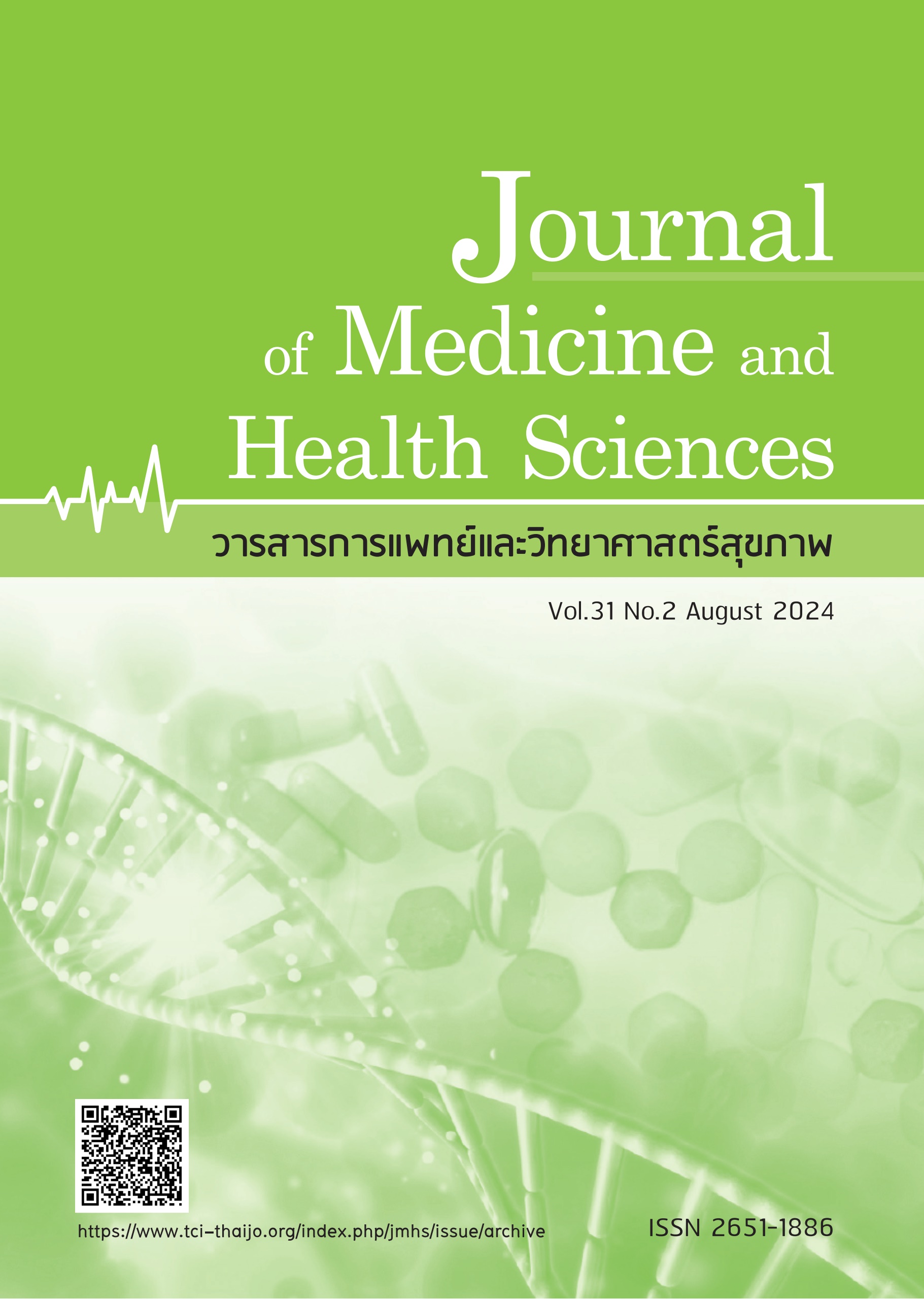Comparison of efficacy and recurrence of intralesional Verapamil and Triamcinolone injection for postoperative ear keloid treatment: A randomized controlled trial
Keywords:
ear keloid, ear keloid excision, triamcinolone, verapamil, intralesional injectionAbstract
Keloids are abnormal scars caused by an excessive repair process without interruption and extend beyond the original boundary. There is no single effective treatment modality and surgical removal has a recurrence rate of 45 to 100%. Multimodality therapy combining steroid injections with surgery decreases recurrence. Verapamil is now included as an alternative treatment for keloids in European guidelines due to its ability to improve keloids appearance by reducing and modifying the scar, with low adverse effects. This clinical trial investigated the efficacy of two treatment methods for ear keloid excision. Fifty-two patients who met the inclusion criteria underwent ear keloid excision. They were then divided into two groups: 26 patients received an intralesional triamcinolone injection (group T), and the other 26 patients received an intralesional verapamil injection (group V). The injections were administered immediately after surgical excision and repeated 4 weeks later. Patients were regularly followed up every 8 weeks for one year. The results revealed that the recurrence of ear keloid scars was observed in 4 patients (15.4%) in group T and 6 patients (23.1%) in group V at 44 weeks after surgery. Both groups showed significant improvements in the Vancouver Scar Scale (VSS) scores. Group T experienced quicker resolution of skin redness or vascularity, pliability, and total VSS scores while pigmentation in group V demonstrated a faster response. Significantly more complications were recorded in group T compared to group V such as telangiectasia and dermal atrophy. In Conclusions, intralesional verapamil injection after ear keloid excision was an effective and non-inferior treatment compared intralesional triamcinolone injection, resulting in reduced post-treatment complications.
References
Bayat A, Arscott G, Ollier WER, et al. Keloid disease: clinical relevance of single versus multiple site scars. Br J Plast Surg 2005;58:28–37.
Brissett AE, Sherris DA. Scar contractures, hypertrophic scars, and keloids. Facial Plast Surg 2001;17:263–72.
Lu WS, Zheng XD, Yao XH, et al. Clinical and epidemiological analysis of keloids in Chinese patients. Arch Dermatol Res 2015;307(2):109-14.
English RS, Shenefelt PD. Keloids and hypertrophic scars. Dermatol Surg 1999;25(8):631-8.
Arno AI, Gauglitz GG, Barret JP, et al. Up-to-date approach to manage keloids and hypertrophic scars: a useful guide. Burns 2014;40(7):1255-66.
Jennifer A. Ledo, Jessica savas, Katlein franca, et al. Intralesional Treatment for Keloids and Hypertrophic Scars: A Review. Dermatol Surg 2013;39:1745–57.
Abedini R, Sasani P, Mahmoudi HR, et al. Comparison of intralesional verapamil versus intralesional corticosteroids in treatment of keloids and hypertrophic scars: A randomized controlled trial. Burns 2018;44(6):1482-8.
Adil A, Ilyas S, Kiran R, et al. Comparison of efficacy and safety of Intralesional Verapamil hydrochloride & Intralesional triamcinolone acetonide in the treatment of keloids. Journal of Pakistan Association of Dermatologists 2024;34(1):31-9.
Gauglitz, G. G., Korting, H. C., Pavicic, T., et al. Hypertrophic scarring and keloids: Pathomechanisms and current and emerging treatment strategies. Mol Med 2011;17:113-125.
Ahuja RB, Chatterjee P. Comparative efficacy of intralesional verapamil hydrochloride and triamcinolone acetonide in hypertrophic scars and keloids. Burns 2014;40:583–8.
Baryza MJ, Baryza GA. The Vancouver Scar Scale: an administration tool and its interrater reliability. J Burn Care Rehabil 1995;16:535–8.
Mustoe TA, Cooter RD, Gold MH, et al. International clinical recommendations on scar management. Plast Reconstr Surg 2002;110:560–71.
Froelich, K., Staudenmaier, R., Kleinsasser, N., et al. Therapy of auricular keloids: Review of different treatment modalities and proposal for a therapeutic algorithm. Eur. Arch. Otorhinolaryngol 2007;264:1497–1508.
Kim DY, Kim ES, Eo SR, et al. A surgical approach for earlobe keloid: keloid fillet flap. Plast Reconstr Surg 2004;113(6):1668-74.
Jacobs C, Wilmink J. Combined versus single treatment regimens for keloid therapy using serial intralesional corticosteroid injections, surgical excision, silicone- and/or cryotherapy. JPRAS 2021;29:157-166.
Jung JY, Roh MR, Kwon YS, et al. Surgery and perioperative intralesional corticosteroid injection for treating earlobe keloids: a Korean experience. Ann Dermatol 2009;21(3):221-5.
Lee RC, Doong H, Jellema AF. The response of burn scars to intralesional verapamil. Report of five cases. Arch Surg 1994;129:107–11.
D'Andrea F, Brongo S, Ferraro G, et al. Prevention and treatment of keloids with intralesional verapamil. Dermatology 2002;204(1):60-2.
Shah Y, Garg A, Gaurav P, et al. A study of verapamil in treatment of keloid. Int J Res Dermatol 2018;4:176.
Lawrence WT. Treatment of earlobe keloids with surgery plus adjuvant intralesional verapamil and pressure earrings. Ann Plast Surg 1996;37:167–9.
Wang R, Mao Y, Zhang Z, et al. Role of verapamil in preventing and treating hypertrophic scars and keloids. Int Wound J 2016;13(4):461-8.
Middelkoop E, Monstrey S, Téot L, et al. Scar management – practical guidelines. Maca-Cloetens: Elsene; 2012: pp 109.
Copcu E, Sivrioglu N, Oztan Y. Combination of surgery and intralesional verapamil injection in the treatment of the keloid. J Burn Care Rehabil 2004;25:1–7.
El-Kamel MF, Selim MK, Alghobary MF. Keloidectomy with core fillet flap and intralesional verapamil injection for recurrent earlobe keloids. Indian J Dermatol Venereol Leprol 2016;82(6):659-665.
Mane, B.S., Gavali, R.M. Our Experience at Tertiary Medical College—Intralesional Injection of Triamcinolone Acetonide Versus Injection Verapamil Following Keloidectomy with Fillet Flap in Auricular Keloids. Indian J Otolaryngol Head Neck Surg 2024;76:237–44.
Margaret Shanthi FX, Ernest K, Dhanraj P. Comparison of intralesional verapamil with intralesional triamcinolone in the treatment of hypertrophic scars and keloids. Indian J Dermatol Venereol Leprol 2008;74: 343–8.
T. Maeda, E. Funayama, Y. Yamamoto, et al. Long-term outcomes and recurrence-free interval after the treatment of keloids with a standardized protocol, Journal of Tissue Viability 2021;30:128-32.
Patricia L., Suzanne M., Fiona M., et al. Verapamil is Less Effective than Triamcinolone for Prevention of Keloid Scar Recurrence After Excision in a Randomized Controlled Trial 2016;96:774–8.
Boggio RF, Freitas VM, Cassiola FM, et al. Effect of a calcium channel blocker (verapamil) on the morphology, cytoskeleton and collagenase activity of human skin fibroblasts. Burns 2011;37:616–25.
Downloads
Published
How to Cite
Issue
Section
License
Copyright (c) 2024 Journal of Medicine and Health Sciences

This work is licensed under a Creative Commons Attribution-NonCommercial-NoDerivatives 4.0 International License.



